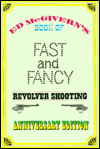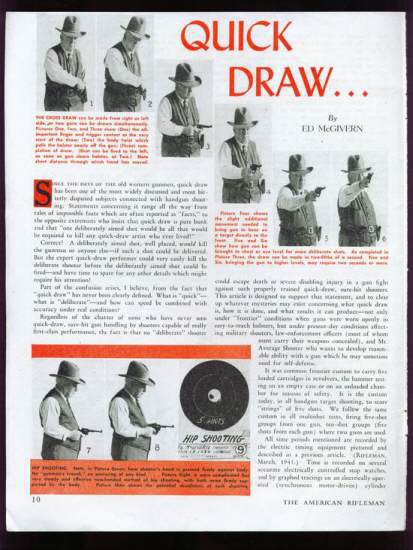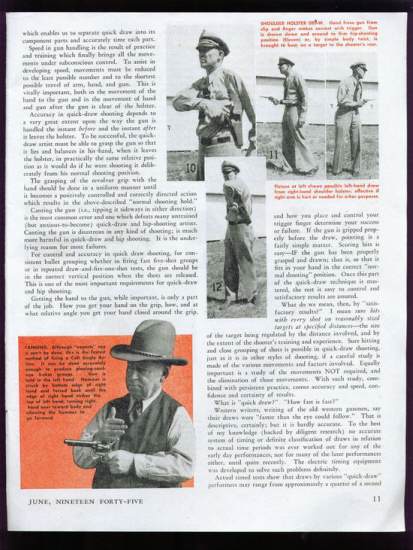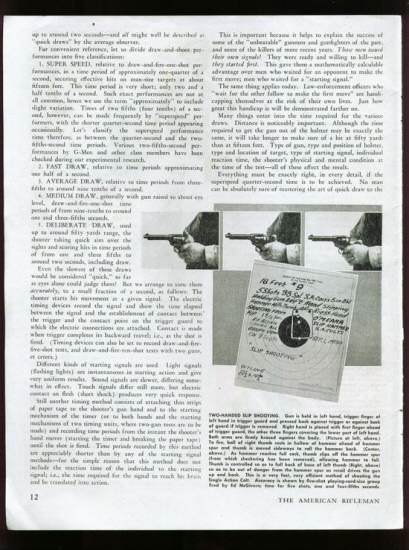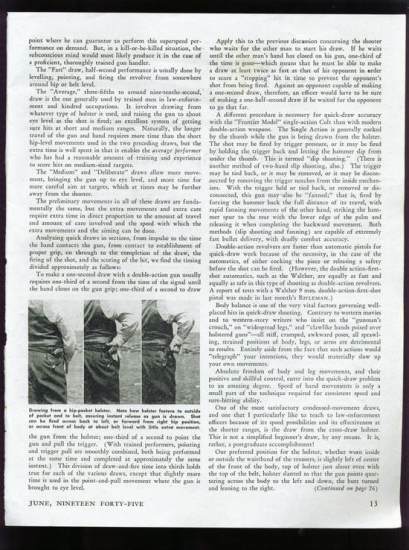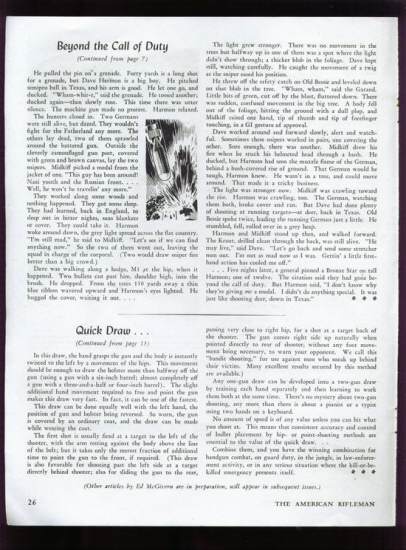American Handgunner > July-August, 2003Uncle ed knows - Better ShootingDave Anderson Around 1970, during my university days, I had a summer job on a survey crew. The small city where we were headquartered had a rather decent library. A librarian in the past must have been a hunting and shooting enthusiast, for among the books I recall were Shotguns by Keith, Bell of Africa, Hatcher's Notebook, and Larry Koller's Shots at Whitetails. The book that got me in trouble, though, was Ed McGivern's classic Fast and Fancy Revolver Shooting. I was especially fascinated by McGivern's speed shooting feats. McGivern and a man named Frank Fish developed quite sophisticated (for the era) timing mechanisms connected to the revolver's trigger guard and activated by trigger movement. On September 13, 1932, using this timing gear, McGivern fired five shots from five yards into a group the size of his hand, in a time of 2/5 of a second. The shooting was done at the Armory headquarters at Lewiston, MT, witnessed by officers of Company K, 163rd Infantry. He repeated this performance on several subsequent occasions. Shortly after I read this, my crew and another survey crew were working in the same area. When noon came we moved our trucks to the sparse shade of some trees. We were gabbing along as we ate our lunches, and then I made a big mistake. I mentioned this fabulous character I'd been reading about, who could fire five shots in 2/5 of a second. Any credibility I had with those guys, on any matter whatever, was gone in that instant. The guys just roared with laughter, practically rolling on the ground. If I'd said five shots in one second, they would only have called me a liar (or words to that effect). But 2/5 of a second? It was as though I'd claimed someone could run a mile in two minutes, or high jump twenty feet. From then on whenever there was a job to be done someone would be sure to say, "Let Anderson do it, it'll only take him 2/5 of a second." Soon it became a nickname. It was a long summer. When it ended we went our ways, and I haven't seen any of the guys from that day to this. I'm sure if I did the first thing he'd say is "How's old Two-Fifths doing these days?" COPYRIGHT 2003 Publishers' Development Corporation
American Handgunner > July-August, 2004How fast is fast?Gentleman Jerry Miculek tackles McGivern's record Charles E. Petty · [Video of Jerry Miculek in action... 800Kb/40sec] A lot of guys like me grew up with awesome respect for the feats of Ed McGivern. Legendary is the only word that fits. I remember those grainy black and white movies of the short squat man in the big hat and the five shots that sounded almost like one. McGivern did most of his recorded high speed shooting in the 1930s using the best timing equipment of the period--stopwatches. He used a solenoid operated plunger to start and stop the clock that was certified to be accurate to 1/20 (.05) sec. The feat everyone know, about is firing five shots in 9/20 (.45) seconds. All the shots were within an area about the size of a playing card. Without taking anything away from his accomplishments there is an inherent source of potential error in the timing. If each tick of the clock took .05 seconds then there is the opportunity for that much error at each end of the event and mean that the very precise time--by modern standards--could be from .040 to .050 seconds. The gun he used was a Smith & Wesson M&P Target revolver. It had a 6" barrel and wore the famous McGivern gold bead front sight. The world knows the M&P as the longest lived revolver ever made. When S&W started using model numbers it became the Model 10, the one with adjustable sights became the Model 14 and when stainless steel took over, it would have been a Model 64 or 65. [ GunBlast · History · Models] The New GuyNow let me tell you about McGivern's successor. He's Jerry Miculek (properly pronounced Mish-u-lak, by the way), a soft spoken 49 year old Louisiana Cajun who made a big splash in practical and speed shooting competitions some years ago by using revolvers to thoroughly clean the clocks of guys--good shooters--using autoloaders. I know these things because I watched both at matches and clinics how Jerry could take a S&W Model 625, shoot it just as fast or faster than the best autoloaders and, using moon clips, reload even faster. Anyone who thinks revolvers are obsolete don't know nothin'. It was simply ordained Jerry would go after McGivern's records. We know about the five-shot speed but there was another feat of his not many know about. McGivern tells the story in his book of shooting five shots from each of 10 guns in 25 seconds. This time Jerry went after that one too. The occasion of Jerry's effort was the NRA National Police Championship held in Jackson, Miss., September 22-25, 2003. This is a big deal match that brought 460 shooters from 35 states and four foreign countries together for four days of competition with both revolvers and autoloaders. It's held at the Jackson PD range, as it has been since 1989. Short History LessonNRA PPC (Police Pistol Combat) match has a total of 150 rounds fired at ranges from seven to 50 yards on the standard B-27 silhouette target. Positions include: prone, kneeling, sitting, and standing. Some of the standing portion provides for the use of a barricade for support and cover. The hook for this one is if you shoot on the right side of the barricade you use your right hand but on 'tother side it's the left. This means everyone must shoot a few rounds with their weak hand. With the exception of a stage at seven yards everything can be fired with two hands. For revolvers it's all double-action except for the 50 yd. stage where single-action is permitted, but almost everyone shoots that double-action too. Of course law enforcement handguns have undergone a paradigm shift to autoloaders so, in 1990, the match rules were changed to permit the shooter to use either a pistol or revolver. But the real change came in 1992 when a separate class was established for pistols and the National Champion became the shooter with the best score for both guns. This year the winner was a soft spoken Mississippi State Police Lieutenant named Philip Hemphill who won the revolver portion outright with a score of 1,496-120x out of a possible 1,500. He's the kinda guy who probably said "excuse me" if he had to pop some miscreant during his days on the road. He only managed to finish third in the pistol phase but the combined score bested two shooters from the famed U.S. Border Patrol team. Agents Robert Vadasz and Clay Tippit finished second and third only two points behind Hemphill's 2,988 of a possible 3,000 points. Hemphill is not exactly a stranger to the winner's circle. This year was his sixth National Championship and he is one of only two men to shoot a perfect 1,500 score. He's done it twice. The PPC nationals are a big deal for shooters, but there are also social and entertainment events. Corporate sponsorships paid for banquet dinners two nights, the Jackson Police Department hosted a fish fry at the range and shotgunner John Satterwhite put on a trick shooting show, but the event that captured the most extra attention was Miculek's effort to better McGivern's records. The HappeningJerry is one of those genuinely nice guys who doesn't let fame get in the way. I've known him for some time but it was still impressive to watch him talk to folks with no hint of pretense. I've also watched professional athletes, you know football, baseball and basketball players who are much too important to speak to a kid or sign a piece of paper. But put this in perspective, there are literally hundreds of players in each of those sports, but right now there is only one guy in the world who can do what Jerry does with a revolver. I know the pond is smaller, but it sure is refreshing to know you don't have to be a jerk to be good at sports. Timing is a lot better now and Jerry used a group of three PACT timers that started with the sound of the first shot. Standing there watching, it didn't really seem very fast. I guess I was expecting something like the ripping sound of a minigun and as he began warmups Jerry was actually complaining he couldn't seem to "wake up" his finger. He griped aloud about "sixty" or "fifty-nine" and was obviously not happy with his performance. He went through quite a few runs--maybe eight or ten--and ended each with a glance at the timer and, "Another fifty-nine." He's complaining about shooting five shots in .59 seconds! And there was another dynamic at work not always easy to see--the effect of the crowd. "It's hard to get cops enthusiastic," he told me. "They think you're trying to sell them something." But gradually the crowd got into it and you began to hear, "Go Jerry," or other support. You could see Miculek begin to perk up too, but the fifty-nines still came. So he changed gears. Another of McGivern's feats was to fire five shots from each of 10 different revolvers in a time of 25 seconds. Miculek's goal was to fire six shots from 10 guns. "I think I can do it in 20 seconds," he told me. The drill was to set up 10 identical S&W Model 64 revolvers, all completely unmodified. He did this by laying a strip of carpet on the bench mid then using boxes of ammo to support each gun in an upright position with the grip in a position where he could grab it as he laid the other gun down. Again there were a couple of hiccups. On the first attempt he short-stroked the trigger on about the third or fourth gun and missed a shot. He just stopped, told the crowd what had happened, and set everything up again. Practical JokerHe was being assisted by famous practical shooter J. Michael Plaxco who also works as a law enforcement representative for Smith & Wesson. Between them the guns were reloaded and Jerry got ready to go again. At the beep of the PACT timer things really started to happen. The first and second guns were emptied in a flash but when he picked up the third all we heard were six amazingly loud clicks. Miculek lowered the gun and turned to see Plaxco doubled up in laughter. What followed was some laughter and mutual finger-pointing, with each man saying, "I though you loaded it." Folks, I don't know whether Plaxco did it on purpose or accidentally, but it was just the icebreaker needed to really get the crowd involved. They laughed and then cheered as all the guns were loaded and checked and Jerry got ready to go again. You could feel the atmosphere change. This time there were no glitches and I almost forgot to take pictures for it was truly an amazing sight. One after another the revolvers seemed to jump into his hand, empty themselves and fall to the table. In far less time that it takes to read write this sentence he was done. The timers were consulted and an NRA official came forward to verify the result: 17.12 seconds. The crowd went wild--really. And with the ice truly broken Miculek set up again for the five shot effort. This time you could feel the atmosphere change as a confident Miculek stepped up. Once more five shots ripped out almost as one and the timer showed .57 seconds. "You live or die by a couple of hundredths of a second," he said. The target showed five solid hits and once more the NRA referee verified the result. Jerry talked to the crowd awhile and answered a few questions while everything was tidied-up and the ammo put away and then the spectators were invited to examine the guns. The only notable modification was that all wore grips Jerry had designed. Otherwise the Model 64s were just as they had come from the factory. It's fairly common practice for shooters to cut a coil or two off the rebound spring to lighten the trigger pull, but that's the last thing he wants because his type of shooting depends on the spring pushing the trigger forward so he can do the next fast shot. No mods are permitted. The gun he used for the 5-shot effort came from the S&W Performance Center in 1994 and is basically a Model 66 with a special "V"-shaped, ported barrel. The action is stock, although Jim Rae, the Performance Center's revolver magician, who was there, said that it had been "smoothed up" a bit but everything was stock. The ammo he used as a standard target .38 Special handload of 2.7 gr. Bullseye with a 148 gr. cast wadcutter bullet, similar to what McGivern shot. When you talk to him it's easy to see Jerry isn't just some guy who can shoot fast. He's a serious student who can talk about the mechanics of both firearm and human, and who is continually thinking about how to do better. I can't begin to count the number of instances where the statement, "timing is everything" would apply. Modern electronic timers such as the PACT Mk. IV that Jerry uses, break a second into four million parts (0.00000025). So what we have here are two thoroughly modern records that await breaking. Miculek wasn't completely happy with the 5-shot time and has done better in training, so we'll surely see future attempts. I sure hope to be there--this was a fun assignment. COPYRIGHT 2004 Publishers' Development Corporation
| |
|
www.FindArticles.com GunsMagazine Jan 2002 issue Jerry Miculek's rifle speedshooting techniques - RIFLEMAN
Jerry Miculek is renowned for his phenomenal prowess with revolvers. He is also an excellent rifle shooter. A testament to this are his many victories in rifle speed events, which require hitting small steel plates at various ranges against the clock, usually from unsupported positions. Miculek recently talked about some of his winning techniques. It should be noted that these are match techniques that may not be appropriate for hunting situations.
| |
|
"FAST AND FANCY REVOLVER SHOOTING" THE LESSONS OF ED MC GIVERN By: Skip Gochenour TeddyTactical.com Continuing our study of historical masters, we will look at Ed Mc Givern. In the 1930's McGivern wrote extensively on his experience with handgun shooting. In his book of over 480 pages he described training concepts that are completely familiar today. In keeping with the dictate, "if you want to learn a new technique, read an old book!" we will look at some of the lessons McGivern wrote about nearly ¾ of a century ago. Using hand built electronic timers; McGivern recorded five shot, unsighted groups that could be covered with a "silver" half-dollar, fired at 15' in 45/100 of a second. The average modern auto-pistol cycles about 13 times a second. McGivern's revolver was cycling at the outer reaches of the modern auto-pistol's mechanical capabilities. He recorded one shot draws, with hits on humanoid targets, in 2/5ths of a second. He recorded one shot draws, with hits on humanoid targets at 50 yards in 2 seconds.
McGivern's book is one of many, written long ago that reminds us that, where men and fighting are concerned, there is nothing new under the sun! An article of Ed McGivern: My Challenge to Hollywood Hot Shots, appears in the Jan-1957 issue of Guns-Magazine. Quick Draw Applied: a 5-page article
in June 1945 American Rifleman
|
